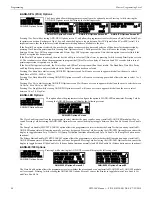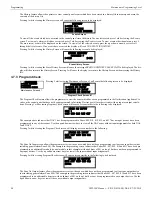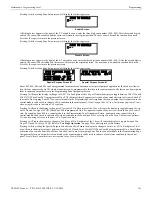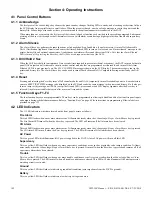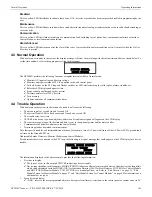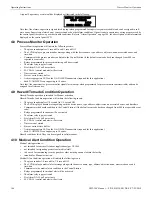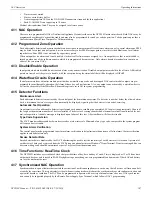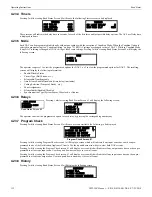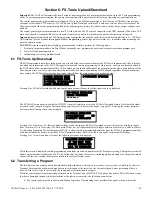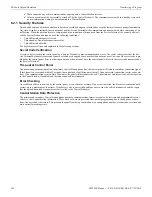
NFW-50X Manual —
P/N LS10129-001NF-E:C 7/25/2018
107
NAC Operation
Operating Instructions
•
Timers are not started
•
Store event in history buffer
•
Activate appropriate LED on the N-ANN-LED annunciator (required for this application)
•
Each N-ANN-LED can support up to 10 zones.
Medical alert conditions latch. They can be assigned to software zones.
4.11 NAC Operation
There are two programmable NACs (Notification Appliance Circuits) resident on the NFW-50X main circuit board. Both NACs may be
programmed as silenceable or nonsilenceable and may also be programmed for steady or coded operation. Coded operation provides a
choice between March Time, Temporal or California coding.
4.12 Programmed Zone Operation
Each addressable detector and monitor module can be assigned to a maximum of five software alarm zones. A general alarm zone Z000
may be listed for output (control) points, but it is not necessary to list Z000 for input points, since this is the default zone for all alarm
input devices. Zone Z000 is not activated by supervisory points.
When an input device alarms and is not disabled, it activates all software zones assigned to it. An output device that is not disabled is
turned on when any of the software zones to which it is programmed become active. Only alarms, hazards/tornado alerts can turn on
either of the two main NACs.
4.13 Disable/Enable Operation
Input points which are disabled do not cause an alarm or any zone activation. Disabled output points are held in the off state. All disabled
points are treated as if they were in trouble, with the exception being the status label that will be displayed is
DISABL
.
4.14 Waterflow Circuits Operation
If an alarm exists from a monitor module point that has a waterflow type code and its mapped NAC control module outputs are pro-
grammed for nonsilenceable operation, the Alarm Silence key will not function. Also, any output zone activated by a waterflow device
will not be silenceable if the Waterflow Silenceable option is set to NO in system programming.
4.15 Detector Functions
Maintenance Alert
Each addressable detector is monitored by the control panel for its maintenance status. If a detector is near but below the allowed alarm
limit, a ‘maintenance alert’ message will automatically be displayed, signaling that the detector is in need of servicing.
Automatic Test Operation
An automatic test of an addressable detector is performed each minute, resulting in a complete SLC loop test in approximately 5 hours (if
the loop has the maximum number of devices installed). The detector’s sensing chamber and electronics are functionally tested for nor-
mal, safe operation. A trouble message is displayed upon failure of this test. A System Reset will clear this trouble.
Type Code Supervision
The FACP monitors addressable hardware device codes at slow intervals. Mismatch of any type code, compared to the system program,
will cause a device trouble.
System Alarm Verification
The control panel may be programmed to perform alarm verification to help eliminate the nuisance of false alarms. Alarm verification
applies to smoke detectors only.
Smoke Detector Data
Smoke detector data is monitored by the FACP, eliminating the need to test the sensitivity of each detector at its location. A printout of
each detector’s data can be retrieved from the FACP using an optional printer or Windows
®
HyperTerminal. Detector sensing ability can
decrease with age and should be monitored as part of a system’s routine maintenance.
4.16 Time Functions: Real-Time Clock
The NFW-50X includes a crystal-based clock that provides time of day, date and day of week. Time is displayed as 12 or 24 hour time
with month/day/year and is stored in RAM. Daylight savings time change-over is programmable and automatic. If both AC and battery
are lost, the time must be reset.
4.17 Synchronized NAC Operation
Synchronization is a panel feature that controls the activation of notification appliances in such a way that all devices will turn on and off
at exactly the same time. This is particularly critical when activating strobes which must be synchronized to avoid random activation and
a potential hazard or confusion. The FACP can be programmed to operate with a variety of manufacturer’s devices. NAC synchroniza-
tion can only be supported properly by the Remote Power Supply Sync Terminal, which follows NAC 1 programming.


